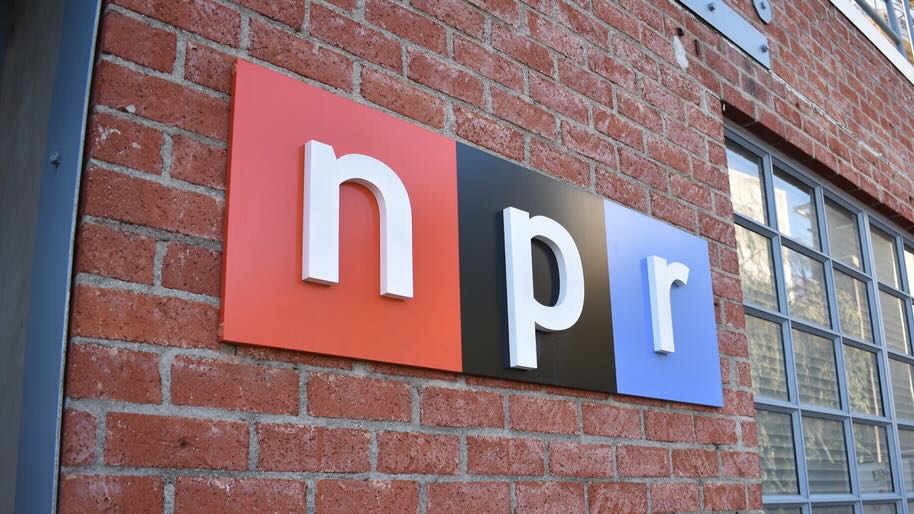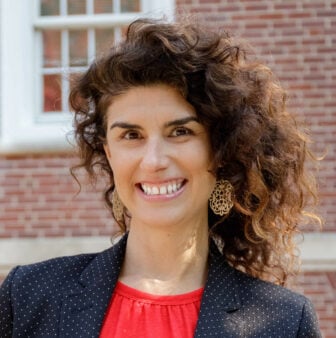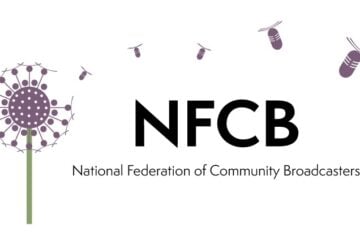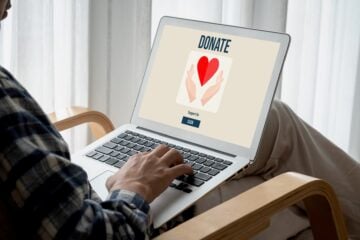Rollout of NPR Network donations tests more than the public radio giving experience

Tyler Falk
Public radio’s end-of-year giving campaign is underway, with one big difference this year. People can now give directly to something called the NPR Network, rather than — or in addition to — member stations.
The new donation stream is part of a broader initiative, also called the NPR Network, that won approval from NPR’s board in June. It’s a far-ranging plan to grow audience and revenue and to establish the NPR Network as a unifying brand for the hundreds of member stations across the country. The goal is to double NPR revenue and station membership by 2030.

NPR estimates 20 million people consume its digital content — such as podcasts, blog posts and Tiny Desk Concerts — but remain unaffiliated with member stations. This represents a huge group of potential donors, said NPR Chief Development Officer Leora Hanser.
“There is a tremendous opportunity to be reaching … more of our audience, and really be trying to drive them into the donation funnel,” Hanser said.
The idea is that, for some digital-only users, it may be more appealing to give directly to NPR than to a radio station they’ve never listened to. But Hanser said the ultimate goal is to turn those donors into members of their local stations.
“We’re not interested in developing a membership program,” Hanser told stations during a webinar hosted by Greater Public last summer. “In many ways, we are creating a lead-generation machine.”
How it works
When someone clicks the “donate” button at the top of NPR.org, the form defaults to their local member station, but they have the option to give to the NPR Network instead. If they choose to donate to the network, their information will be checked against the National Reference File maintained by the Contributor Development Partnership.
CDP will then let NPR know whether or not a donor has had a relationship with a member station in the last four years. If the answer is yes, NPR will alert the station of the gift, but otherwise stay out of the relationship. If the answer is no, NPR will begin the process of trying to turn that donor into a member of a local station.
“The main source of new donors for public radio is pledge. That’s not good. … Stations are too exposed by relying on one source of new donors.”
Michal Heiplik, Contributor Development Partnership
Exactly how that conversion will be accomplished remains to be seen. The option to give directly to NPR went live in early November; donor data will start flowing in January. Right now, every NPR Network donor receives the same communication: a tax receipt and thank you email signed by Hanser.
In the future, NPR and stations hope to tailor messaging to individual donors’ interests, acknowledging that people who listen to Pop Culture Happy Hour are likely to respond differently than news junkies who never miss an episode of the NPR Politics Podcast.
At this early stage, it’s unclear what strategies will work best to turn these digital-only users into station members, said CDP President Michal Heiplik. He looks forward to crunching the numbers to find new best practices for digital fundraising.
“We have to figure out the relationship between local and national in that stack of giving,” Heiplik said. “When you, as a donor, think about giving, what do you think about? Do you think about the show? Do you think about NPR? Do you think about your local station? Who are you writing a check to?”
For many in public radio, there is a sense of urgency to answer these questions. Some development professionals at stations feel behind the eight ball when it comes to tapping the goodwill and wallets of digital users. The rate at which stations are adding new members is slowing, with some stations seeing declines by as much as 40%, according to CDP’s year-over-year analysis of new donor data from June 2021 to June 2022.
“We have no time to waste,” Heiplik said. “The main source of new donors for public radio is pledge. That’s not good — one leg to stand on. Digital is still not big enough. … Stations are too exposed by relying on one source of new donors.”
A ‘2.0 approach’
In 2019, NPR’s compact with member stations changed, incentivizing NPR to invest more deeply in growing station membership. Elyse Poinsett, director of marketing strategy at NPR, said that was the beginning of a “2.0 approach” to collaborative fundraising online, and renewed energy for trying new things at both the mothership and stations.
In 2020, NPR worked with stations to pilot the new “streamlined giving experience,” which allows donors to give to stations on NPR.org without being redirected to individual station websites.

“A lot of our forms across public media are somewhat clunky,” said Rashad Brown, director of membership at KUOW in Seattle, one of the stations that participated in the pilot. “The whole goal of that was to increase conversions … by utilizing a little bit more mobile-friendly [interface and] reducing the technical barriers to get donations processed quicker. And that was successful.”
Last fiscal year, KUOW saw a conversion rate of nearly 10% for NPR digital users in its metro area who had no prior donation history with the station, according to Brown. That’s an increase from just 1.6% the previous year. In FY 2023, the station is on track to reach a 13% conversion rate.
Results across the network have been mixed. WYPR in Baltimore obtained a brand new major donor through the platform, but overall it hasn’t had a huge impact.
“I have been surprised at just how we haven’t seen very strong traffic coming from there, at least for our station,” said Director of Development Carolyn Jewell.
Since Nov. 1, when the NPR Network donation option launched, about half of the donations KUOW has received have been from new members, Brown said. That’s compared to about a quarter of donations coming from new members during a typical pledge drive.
Joel Sucherman, VP of audio platform strategy at NPR, said he’s heard from stations where 60% of donations are from people unknown to the station.
“That’s a really telling statistic in terms of how we’re finding folks that wouldn’t be moved by a radio pledge drive,” he said.
NPR and stations are also experimenting with more traditional digital fundraising. A series of emails penned by Morning Edition host Leila Fadel and sent by NPR led to additional gifts in September for WGLT and WCBU in central Illinois.
“Normally it’s just steady, right? Nothing to write home about,” said Development Director Melissa Libert. “When there’s a concentrated push from NPR, we always see a bump.” If an average month sees five gifts to WGLT/WCBU coming in from NPR’s website, a marketing push from NPR can help double that number, she said. It’s not a huge jump but helpful over the long term, particularly for small stations.

WGLT and WCBU also use the streamlined giving experience; Libert called it a “no brainer” for stations in college towns, where audiences skew younger and more diverse. The stations are also participating in the NPR+ pilot currently underway, which gives donors to 33 stations special access to bonus podcast content.
There is a strong appetite at NPR and some member stations to move away from the pilot phase and into the implementation phase.
“It just needs to be the thing that we do and we have to get better at it, we have to practice it more,” said NPR’s Hanser. “We have to stop talking about it as a project and just think about it as how we’re actually going to be doing our work every day.”
This is uncharted territory, but it’s necessary to forge ahead, said Vijay Singh, head of product at CapRadio in Sacramento, Calif.
“I would rather have a system that we can iterate on than to continue to theorize about what it is,” he said.
Developing trust
Prior efforts at collaborative fundraising have sputtered or proven difficult to reproduce across the network. In 2020, just before the pandemic hit, NPR launched a two-year Collaborative Fundraising Pilot focused on major giving.
“We had a really open conversation about why hasn’t this worked? What are the things that are getting in the way?” said Brendan Kinney, SVP of development at Vermont Public, one of the 15 stations that participated in the pilot. “I think at the root of it for many stations, there was a lack of trust between the motives of NPR and the concerns of member stations.”
As a result, NPR and the stations developed five core principles to guide their work: transparency, donor-centricity, a collaborative mindset, an abundance mindset and a learning mindset.
About a year into that effort, NPR convened a separate advisory working group with stations to reimagine how the network would evolve into the digital future. The group embraced the five principles developed by the CFP, and their work resulted in the ambitious NPR Network plan.
Still, concerns about transparency linger. In a letter to the NPR board prior to the June vote, Oregon Public Broadcasting President and CEO Steve Bass called communication about the plan “vague,” saying that the “NPR Network will not succeed without higher levels of trust with its member organizations.” Communication about the NPR Network has improved in the intervening months, Bass said, but the board still needs to demonstrate an increased commitment to transparency.
“I would love nothing more than for this to work exactly the way they say, but I’m not completely convinced.”
Nancy Wood, The Public’s Radio
One opportunity it will have to do that involves those NPR Network donations now coming in, which have little in the way of guardrails for spending. According to the June 2022 board book, the funds “may be used to fund NPR Network infrastructure and/or may be distributed to Member stations.” NPR management will propose how to spend the money, but its board of directors will have the final say.
Sucherman said the board itself is the guardrail, with 12 of its 22 members representing public radio stations.
“They hear from their colleagues, and we’ll hear it if [the NPR Network fund] is not doing what they feel it needs to do,” he said.
Some in the network feel guarded and are waiting to see what NPR does with the money — and whether they see an increase or decrease in donations coming from NPR.org.
Nancy Wood, chief progress officer at The Public’s Radio in Providence, R.I., is concerned that donors who might otherwise have given to the station will instead give directly to the NPR Network. “Now [NPR’s] argument, and I think it’s a fair one, is maybe those people aren’t listening locally at all,” she said. “I would love nothing more than for this to work exactly the way they say, but I’m not completely convinced.”
Wood said about half of the gifts that have come via NPR.org between Oct. 1 and Dec. 20 were from new members, but that represents no change from the same time period last year. Overall giving to The Public’s Radio via NPR.org remains flat as well. The station has opted out of NPR’s digital fundraising pilots, instead focusing on making in-house improvements.
“There’s potential. It could be fabulous or it could just be a big freaking song and dance … that’s the next step to [NPR] saying they don’t need us,” Wood said. “But we need to do something to capture [digital users], and NPR is bringing more people to the table than we can.”
An existential threat (a few, actually)
For years, people in and around the business have talked about the inevitable decline of FM radio. While the most dire predictions haven’t been borne out — FM radio still accounted for 40% of audio listening across platforms in January 2021, according to a study by NPR and Edison Research — NPR is planning for an increasingly digital future. CEO John Lansing called the NPR Network plan the “first step” in the next half-century of the organization. That’s about how long NPR has been around, period, and it’s not unreasonable to ponder whether the mothership will still need member stations as a distribution network once on-demand listening surpasses FM radio listening.
When that happens, what exactly will NPR need member stations for?
“We need to … find unified ground with all of us in public radio, so that we are not fighting amongst ourselves as we try to take on these giants that are the new competition.”
Joel Sucherman, NPR
“The New York Times would die to have as many local newsrooms as we do,” NPR’s Hanser said. “That is, to a degree, our secret sauce when we talk about public media. So anything and everything that we can do to strengthen local stations — quality, local journalism that we know we have — is really what we should be doing.”
NPR sees a huge opportunity to become an even bigger player in an increasingly competitive media marketplace by capitalizing on the size and reach of the public radio system. This is a main driver of the ambitious goal of doubling station membership and system revenue by 2030. The continued encroachment of other media organizations into the audio journalism space only adds to the sense of urgency.
“We need to be sure that we are able to find unified ground with all of us in public radio, so that we are not fighting amongst ourselves as we try to take on these giants that are the new competition,” NPR’s Sucherman said.
While some stations are all-in on the new vision and direction of NPR, others are more ambivalent.
OPB’s Bass said the question for him is less whether NPR will continue to need OPB, but rather whether OPB will continue to need NPR.
“If NPR doesn’t get interested in how we are going to build an ecosystem with strong local reporting for the sake of local communities that’s connected to a broader network, how long is it until the New York Times or the Washington Post or somebody else figures that out and comes calling?” he said. “… Would I turn down a partnership with another entity? I’d certainly talk to them.”
OPB has opted out of both the streamlined giving experience and the NPR+ pilot, Bass said. The NPR Network plan doesn’t strike him as the transformational document it’s been touted as.
“Right now, the NPR Network is kind of a way of talking about membership and some podcasts,” he said. “It’s not necessarily a way of centering the future of news. It could be, but that’s the mountain that needs to be climbed.”
That’s the work of NPR’s new Network Growth team, Sucherman said. He and Senior Director of Network Growth Dan McCoy pointed to several initiatives already underway, including the NPR podcast network and a new app slated to launch in 2023. The name of the app isn’t finalized, but it is meant to replace both the NPR One app and the current NPR app. The Android version is expected to be available in the first quarter of 2023, with the iPhone app to follow.
Additionally, McCoy said NPR is working to make sure audiences can find content from NPR and from their local stations wherever they are.
“It is not only a mobile app, but it’s also a platform. People can access on [smart] devices, on [Apple] CarPlay, on Android Auto Automotive,” he said. “As the [car] dashboards continue to change, to be less of the left-to-right dials and more touchscreens, we want to make sure that public radio continues to have a place … and stations don’t have to spend a penny.”
The opportunity is tremendous, the challenges are many, and the stakes are high. A new report from the National Trust for Local News contends that public radio has a key role to play in rebuilding the local news ecosystem.
In an era when national political fights play out at school board meetings and threats like the opioid epidemic and gun violence impact every town in America, there will be no substitute for boots on the ground.
“NPR stations like us who have invested in local content are uniquely positioned to keep democracy and society afloat,” said Ryan Denham, digital content director of WGLT and WCBU. “It’s very urgent to get this math right so that we have the money we need to grow a little bit every year and to hire that extra reporter … so that we’ve created a sustainable nonprofit ecosystem in these [smaller] communities, not just in the big cities.”
Sucherman said it’s not hyperbolic to say that the future of democracy is at stake when discussing how public radio will evolve in the next half-century.
“The beauty of it is, the work that’s done in public radio — [for-profit media can say] it’s truth, justice, the American way and play the music and unfurl the flag, but we feel it,” he said. “That mission is what keeps us going to do this day in, day out.”







I would like to also/together donate to the Corporation for Public Broadcasting (that provides TV programs like PBS). Is that possible with one monthly donation? Let me know how to get this done, if possible.
Hi Dennis,
As far as I know, CPB does not accept donations. CPB’s role is to distribute the annual federal appropriation for public broadcasting to qualified stations across the country. So its funding comes from Congress, not individual donors. Thanks for reading — Mike Janssen, Current digital editor